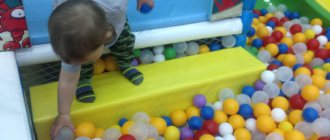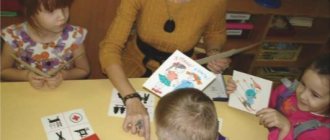Formation of the fundamentals of life safety among preschool children as part of the introduction of the Federal State Educational Standard
Oksana Klimova
Formation of the fundamentals of life safety among preschool children as part of the introduction of the Federal State Educational Standard
The problem of life safety is recognized throughout the world and represents a serious problem of our time.
According to WHO, about 2,300 children die every day worldwide due to unintentional injury or accident:
• In road traffic accidents - 720 children
• From drowning – 480 children
• From burns – 260 children
• As a result of falls – 130 children
• From poisoning – 125 children.
Russia ranks first in the world in terms of childhood injuries.
Often, being drawn into the cycle of everyday life, we forget about how many unexpected dangers await a person on the path of life .
Today, despite serious steps taken by the state in the field of legislative regulation of issues of ensuring normal labor protection conditions and updating the regulatory framework, in practice the root causes of serious accidents are still insufficiently established,
cases involving children, as well as the low level of protection of their health and life .
It becomes obvious that education plays a key role in ensuring the national security of any state and the life of an individual and society. Modern life proves the need to ensure safe life and requires training preschool employees, parents and children in a safe lifestyle in difficult conditions of social, man-made, natural and environmental troubles.
A child, due to his physiological characteristics, cannot independently determine the full extent of the danger of his existence, therefore, an adult is entrusted by nature with the mission of protecting his child - to provide basic knowledge of the basics of safety .
The period of preschool development can be called a kind of foundation from which the construction and development of everything further begins - character, abilities, skills. It is during this interesting and difficult period that the process of socialization begins, the child’s connection with the leading spheres of existence is established: the world of people, nature, the objective world, the foundation of health is laid, solid foundations are laid for the experience of life , a healthy lifestyle .
Working in kindergarten, we notice that children have become less independent, often lack initiative, cannot make decisions on their own, do not know who to turn to for help, do not know how to make the right decision in extreme situations, and do not know safety rules .
We agree with the opinion of many teachers that it is impossible to raise “alienated”
from
life .
In the federal state educational standard for preschool education , the target guidelines state that at the stage of completing preschool education, a child should try to independently explain the actions of people, have basic knowledge about the social world in which he lives, and be capable of making his own decisions, relying on his knowledge and skills, and can follow the rules of safe behavior .
The main goal of instilling safe behavior in children is to give each child the basic life- threatening situations and the characteristics of behavior in them. Safety is not just the sum of acquired knowledge, but the ability to behave correctly in various situations. Therefore, teachers are faced with the need to systematize work in three areas: to anticipate, to teach, to protect.
The concept of safety in preschool educational institutions previously included the following aspects: protecting the life and health of children , ensuring safe working conditions for preschool educational institutions employees. But the modern world has changed its approach to the problem of security ; it also includes such concepts as environmental disaster and terrorism.
The organization of the educational process is associated with the creation of conditions for its implementation, including safe conditions . Today, a lot of attention is required to properly build interaction between all employees of a child care institution.
Life safety is a large block , which includes many aspects: occupational safety, fire, anti-terrorist safety , road safety , healthy lifestyle, lifestyle, valeology, joint activities with medical workers (checking first aid kits in group rooms, conducting classes with preschool employees to provide first aid medical care, etc.).
How can you ensure the safety of the educational process in a preschool educational institution:
— safe environment (fixed cabinets, shelving; absence of poisonous and thorny plants; safe arrangement of plants in a group; equipment of rooms where children are located in compliance with fire safety )
- proper storage of various materials, medicines (scissors, needles are kept out of the reach of children, comply with the requirements; medicines, as well as detergents are kept out of the reach of children);
— furniture selected according to the height of children and its markings;
— marking of bed linen and towels; correct lighting.
— organizing the ventilation process and ensuring the necessary thermal conditions in winter; organization of drinking regime.
— it is necessary to have an automated fire warning system and be provided with the necessary amount of fire fighting equipment;
— all emergency exits must be easily accessible and in good order;
— fire safety ; fire safety regulations must be observed.
— it is necessary to have a plan for the evacuation of people and instructions that determine the actions of personnel to ensure rapid evacuation.
- according to the plan, systematically conduct evacuation exercises in which to practice the actions of all participants in the educational process and kindergarten workers in the event of an emergency.
safety rules with various categories of kindergarten employees; Do not use electrical devices in groups.
Most modern scientific schools and directions have recognized the decisive role of the family and family relationships in the formation of a culture of life safety in children .
Educational organizations, as a rule, play a leading role in the implementation of such components of the process of fostering a safety , such as the formation of a system of knowledge about sources of danger, means of preventing and overcoming them, and the formation of physical readiness to get out of dangerous situations.
The main goals and objectives of forming in preschoolers the foundations of the safety of their own life activities and the formation of prerequisites for environmental consciousness ( safety of the surrounding world )
involves solving the following problems:
- formation of ideas about situations that are dangerous for humans and the natural world and methods of behavior in them;
— familiarization with the rules of that is safe for humans and the natural world around them;
— transferring to children knowledge about safety as a pedestrian and a passenger in a vehicle.
When implementing these goals and objectives, it is imperative to observe the following principles when working with children:
— developmental education;
— scientific validity and practical applicability;
— completeness, necessity and sufficiency;
— unity of educational, developmental and training goals and objectives of the education process for preschool ;
— taking into account the integration of this educational area with other educational areas.
In order for our work to produce positive results, it is necessary to involve parents. We, as people who are more knowledgeable in matters of education, must explain to all raising adults what techniques can be used to teach a preschooler the most effective course of action in order to avoid those alarming situations that the child and his parents have to face in life .
safety measures dictated by common sense may seem elementary, but with a preschool it is necessary to understand and discuss what at first glance seem to be very simple rules of behavior. You can protect yourself and your children from the many problems that a family may face if you constantly care about safety .
safety factor consists of several components:
— protect life and health (biological safety )
;
— maintain the integrity of real estate (material security )
;
- maintain moral, moral and psychological well-being and build human confidence and security (social, psychological safety )
.
When talking about the safety of a preschool child , the following features must be taken into account:
- the child’s desire for independence ( “I myself”
) and the inability to adequately assess one’s strengths and capabilities;
- insufficient experience or (lack of it)
behavior in difficult situations, inability to use safety rules
,
etc. ; We can roughly identify the main sources of danger for a preschooler :
- dangers that he may encounter at home (or household)
;
- dangers of contact with strangers (at home or on the street)
;
- dangers that he may encounter on the street and on the road;
- dangers in nature
activities to form the foundations of security in 5 areas:
Informational - training in the Rules , formation of knowledge on safe behavior .
developmental - the formation of practical skills and habits of safe behavior .
Educational – formation of motivation for responsible behavior.
methodological - methodological support, creation of an environmental development environment (indoors, on playgrounds, territory of preschool educational institutions)
control - a system of control measures to assess the effectiveness of the knowledge and skills acquired by children (questionnaires, monitoring, testing)
We are confident that if you follow certain rules of behavior and teach this to your child from an early age, then most of these dangers can be avoided.




